Peas are cool season crop. It belongs to Leguminceae family. The crop is cultivated for its young, immature pods, which are harvested as a vegetable, and its mature, dried pods, which are used as a pulse. The seeds from both types are separated and utilized accordingly. Peas are highly nutritious, providing significant amounts of digestible protein (7.2 g per 100 g), carbohydrates (15.8 g), vitamin C (9 mg), phosphorus (139 mg), and essential minerals. The tender seeds are also used in soups. Canned, frozen, and dehydrated peas are commonly available for off-season consumption. Like other legumes, peas play a crucial role in sustainable agriculture by enhancing and conditioning the soil.
Season-
In winter, peas are typically sown from mid-October to mid-November. In hilly terrain, the sowing is done in May for an autumn yield. In temperate areas, peas can be planted from October to March.
States-
Himachal Pradesh, Madhya Pradesh, Rajasthan, Maharashtra, Punjab, Haryana, Karnataka and Bihar are the major producing states of Peas in India.
Peas are generally a cool-season crop and grow best in cooler conditions. The ideal temperature for seed germination is 22°C. While seeds can germinate at temperatures as low as 5°C. Higher temperatures can lead to increased seedling decay. Although peas can withstand frost during their early growth stages, frost negatively impacts flowering and fruit development. The optimal average monthly temperature for pea plant growth ranges from 10°C to 18.3°C.
Peas can thrive in a range of soil types, from sandy loam to clay. However, they achieve the best results when grown in well-drained soils with a pH between 6 and 7.5. The crop is not tolerant of waterlogged conditions. For soils with high acidity, apply lime to adjust the pH.
Spacing-
For early pea varieties, use a spacing of 30 cm by 5 cm. For late varieties, increase the spacing to 45-60 cm by 10 cm.
Sowing Depth-
Plant the seeds at a depth of 2 to 3 cm in the soil.
Method of Sowing-
Use a seed-cum-fertilizer drill for sowing on ridges that are 60 cm wide.
Seed Rate-
35-40kg seeds are required for one acre of land.
Seed Treatment-
Before sowing, treat the seeds with either Captan or Thiram at a rate of 3 grams per kilogram of seed, or Carbendazim at 2.5 grams per kilogram of seed. Following the chemical treatment, inoculate the seeds with Rhizobium leguminosorum culture to enhance quality and yield.
Use any one of the following fungicide:
| Fungicide | Quantity (Dosage per kg of seeds) |
| Captan | 3 gm |
| Thiram | 3 gm |
| Carbendazim | 2.5 gm |
One to two harrowing is enough to obtain fine, tilt seed bed. In addition to ploughing, perform 2-3 harrowings and finish with planking to prepare the field. Ensure the field is level to prevent waterlogging. Provide pre-sowing irrigation before planting to promote good seed germination.
Peas, like other legume vegetables, are sensitive to both drought and overwatering. Overirrigation immediately after sowing can lead to poor germination because of hard crust formation. Excessive watering during the earlier stages can also result in excessive vegetative growth. Provide light irrigation every 10-15 days. Special attention should be given to irrigation during critical stages such as flowering, fruit set, and grain filling.
Fertilizer Requirement (Kg/acre)-
| Urea | SSP | MOP |
| 50 | 155 | 40 |
Nitrogen Requirement (Kg/acre)-
| Nitrogen | Phosphorus | Potassium |
| 20 | 25 | 20 |
At the time of sowing, apply nitrogen at 20 kg per acre using 50 kg of urea and phosphorus at 25 kg per acre using 150 kg of superphosphate. Drill the entire dose of fertilizer along the rows.
Weeding needs vary by variety, but generally, peas require one or two weedings. The first weeding should be carried out when the plants have 2-3 leaves or 3-4 weeks after sowing, and the second weeding should be done before flowering. For effective weed control, herbicides are a useful option. Pendimethalin at 1 liter per acre and Basalin at 1 liter per acre are effective in managing weeds. Apply the herbicide within 48 hours of sowing for optimal results.
- Nitrogen-
Symptoms-
- Yellowing of leaves
- Affected plants exhibit stunted growth
- Reduced leaf size
- Poor Pod development
- Pale green color
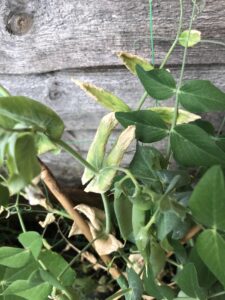
Management-
- Apply Nitrogen rich fertilizer before planting such as urea or ammonium nitrate.
- Ensure proper irrigation.
- Avoid over fertilization
- Practice crop rotation
- Phosphorus-
Symptoms-
Plants may exhibit reduced growth early on, become stunted, and show a darker overall color. Stress conditions can lead to reddening of the stems, petioles, tendrils, and leaf margins. Older leaves are first affected. As the deficit continues, older leaves exhibit patchy chlorosis, while leaf margins become severely chlorotic and die.
Management-
- Apply Phosphorus rich fertilizer before planting such as Single Super Phosphate, Triple Super Phosphate.
- Maintain optimal soil pH levels.
- Avoid over fertilizer.
- Calcium-
Symptoms-
- Leaf Curling and Deformation
- Tips of young leaves shows necrosis and burning symptoms
Management-
- Maintain optimal soil pH between 6-7. If soil is too acidic, apply lime and adjust the pH of the soil.
- Avoid waterlogging conditions
- Magnesium-
Symptoms-
- Interveinal Chlorosis
- Curling of leaves
- In severe deficiency, leaves drop off
- Leads to reduced plant growth
- Leaves may develop purple or bronze tint, particularly in older leaves.
Management-
- Maintain proper soil pH.
- Apply magnesium rich fertilizer
- Incorporate organic manure to the soil
- Avoid overwatering
- Practice crop rotation
- Sulfur-
Symptoms-
- Stunted plants with new foliage that is pale in color.
- Young leaves and tendrils develop a uniform yellowing.
- Severely affected plants show randomly scattered pale brown spots on their yellowing foliage.
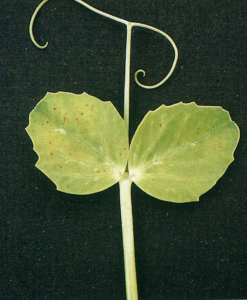
Management-
- Applying gypsum as a top-dressing can resolve the deficiency.
- Potassium-
Symptoms-
- Reduced-sized plants having older leaves with necrotic areas.
- Symptoms are more severe in lighter soils, with less affected plants occurring in patches or in lines.
Management-
Potassium fertilizers applied as top-dressing or in bands will resolve the deficiency.
- Manganese-
Symptoms-
- The initial symptoms involve light-colored new leaves with chlorosis between the veins, which varies among different varieties.
- Interveinal chlorosis of the leaves progresses to necrotic light brown spots, and new leaf tendrils show pale, overly curled tips.
- Stunted plant growth.
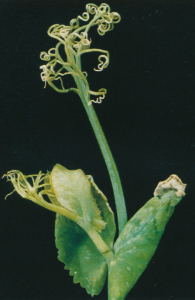
Management-
Foliar Application of manganese sulfate 30.5% @6-7 gm/L of water.
- Boron-
Symptoms-
- Stunted growth
- Seedlings have short internode
- Stems are thick and plants have bushy appearance.
- Young leaves shows marginal chlorosis and curl inwards
Management-
Application of Boron rich fertilizers such as Borax, Boric Acid based on soil test and crop requirements.
- Zinc-
Symptoms-
- Older leaves of young plants can wilt and develop cream-colored edges that gradually spread to the midrib.
- The leaf might turn white and eventually die, leaving a small green area at its base.
- Tendrils may curl
- New leaves might appear small, pale, and curled, and show red-brown spots on both the leaves and upper stems.
- The tissue between the leaf veins turns yellow or white, while the veins themselves stay green.
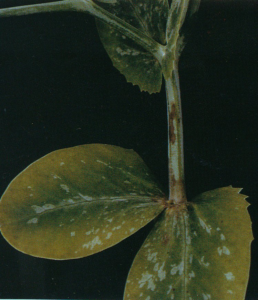
Management-
- Apply zinc rich fertilizers such as zinc sulfate, zinc chelates.
Maintain soil pH between 6.0-7.0 as zinc availability decreases in alkaline soils. Adjust pH with lime or sulfur as needed.
- Marsh Spot-
Caused by- Caused by partial deficiency of Manganese
Symptoms-
- This disorder affects the quality of seeds and can reduce crop yield.
- Central discoloration or brown lesions on the inner surface of one or both cotyledons.
- Younger leaves show mottling, with yellowish areas between the veins, and the newest leaves remain small.
Management-
Application of Manganese Sulphate 17% @1kg/acre
- Chimaera-
Caused by- Caused due to mutation
Symptoms-
- Distortion of leaves
- Stems and Petioles are mostly affected
- Leaves may develop mosaic like appearance
Management-
- Use protocols that are less likely to be genetic mix
- If chiameras result from disease, controlling the disease and preventing infection are key to managing the issue.
- Managing chiameras involves a combination of precise techniques, vigilant monitoring and an understanding of both their potential benefits and challenges.
- Blindness-
Caused by- Caused due to lack of seed germination or poor seed development
Symptoms-
- Seeds may fail to sprout , leaving bare patches where seeds are sown.
- Seedlings that do emerge may be weak, spindly or have stunted growth.
- Seedlings also exhibit wilting symptoms.
- Seedlings may also develop malformed leaves, yellowing or other abnormalities.
- In severe cases, plants may die off.
Management-
- Use high quality seeds from a reputed source.
- Treat the seeds with Thiram @2-3gm/kg of seeds or Captan @5gm/kg of seeds before sowing.
- Avoid planting in extreme cold or hot temperature.
- Maintain consistent soil moisture but avoid waterlogging conditions.
- Rotate crops to minimize the risk of soil borne disease.
- Pea Aphids-
Stage of attack- Flowering & Early Pod stage
Symptoms-
Pea aphids feed on the sap from plant’s leaves, stems, and tender shoots. This feeding activity can lead to several symptoms, including:
- Leaves may exhibit yellowing and mottling, become curled, wilted, or fall off. Additionally, they may develop distorted shapes, stunted growth, or show translucent patches.
- The pods may become misshapen and fail to fully develop. They might also form scaly, leaf-like structures known as enations.
- Plants may also experience reduced dry matter production, cessation of terminal growth, and impairment of flower set.
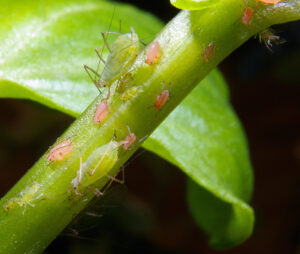
Management-
- Rotate crops to minimize the attack and spread of aphids.
- Incorporate natural enemies to the field such as Lady Beetles, Lace wings, Predatory midges.
- Application of Dimethoate 30 EC@1ml/L of water
- Cutworms-
Stage of attack- Seedling stage
Symptoms-
- The damage from cutworms to peas includes cutting the stems of young plants, climbing up to feed on the foliage, and chewing holes into the pods.
- Cutworms may damage seedlings by cutting them off at the base or dragging them underground into their burrows.
- When cutworms make partial cuts in plants, it can result in wilting.
- Cutworms can cause thin or bare areas to appear in a field.
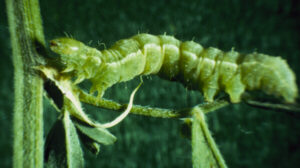
Management-
- Remove weeds and debris from the field.
- Hand picking of larvae at night as they are inactive during night time.
- Use of Deltamethrin 50EC @25ml/100L of water.
- Leaf Miners-
Stage of attack- Vegetative Stage
Symptoms-
- Leaf miners can produce wavy lines, tunnels, trails, and blotches beneath the surface of leaves and soft stems.
- These markings typically appear white, gray, or lighter than the healthy tissue of the leaf.
- The initial signs of leaf blotch in field peas are tiny white spots appearing on the underside of the leaves.
- As the spots increase in size, they burrow into the leaf, developing a concentric ring pattern that changes color from tan at the center to gray and then black at the borders.
- In severe cases, leaves may drop off from the plant and may die off.
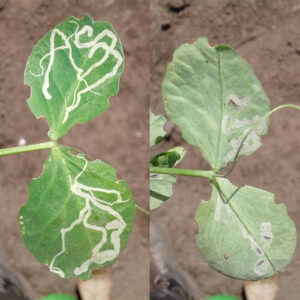
Management-
- Remove infested leaves
- Use of sticky trap
- Use of neem oil
- Application of Monocrotophos 36%SL @1ml/L of water
- Pea moths-
Stage of attack- can attack any stage from flower to pod
Symptoms-
- Inside the pods, you might find tiny cream-colored caterpillars or their excrement.
- Peas become shriveled, discolored, and damaged.
- Infestations severely reduce the yield and quality of crop.
- Peas may become unmarketable.
- Dropping of flowers and young pods.
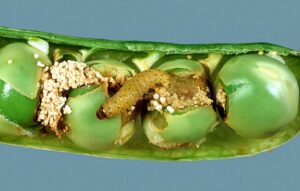
Management-
- Cover plants with insect netting or row covers before the moths start flying to prevent them from laying eggs.
- Remove and destroy the affected plant from the field and maintain field sanitation.
- Use pheromone trap.
- Practice crop rotation.
- Introduce natural enemies such as parasitic wasp in the field.
- Application of Cypermethrin 25EC @0.5ml/L of water.
- Pea Weevils-
Stage of attack- Mature Pod Stage
Symptoms-
- In spring, pea weevils feed on the edges and growing tips of young pea seedlings, resulting in noticeable cut-like damage.
- The damage can make the leaves look tattered, but plants typically manage to compensate. In extreme cases, young plants may shed all their foliage.
- Both pea weevil larvae and adults feed on the seeds, potentially decreasing their weight by up to 30%.
- Pea weevil feeding can greatly diminish the quality of the seeds, making them unfit for human consumption.
- It can also lower germination rates and hinder plant growth.

Management-
- Use of Pheromone trap.
- Remove and destroy the infected plants from the field.
- To manage weevils found in peas after harvesting, in storage, or in purchased seed, fumigation is advised.
- Application of Cypermethrin 25EC @0.5ml/L of water.
- Growing weevil resistant varieties
- Slugs-
Stage of attack- Seedling Stage
Symptoms-
- Slugs leave behind a path of white or clear mucus on leaves, stems, surfaces, walls, rocks, or mulch.
- You may find uneven holes in leaves or perfectly round holes.
- Slugs can feed on young seedlings, as well as consume foliage and stems.
Management-
- Delay Planting.
- Make a beer trap to trap slugs.
- Use Lure
- Rotate crop to distrupt the life cycle of slugs
- Remove and destroy the affected plants from the field.
- Maintain proper spacing between the plants.
- Monitor regularly and manual picking of slugs.
- Use Physical barriers like copper tape or rings around the plants.
- Use Organic slug bait containing Iron Phosphate.
- Avoid over watering
- Use of Mulching.
- Leaf Edge Beetle-
Stage of attack- Reproductive Stage
Symptoms-
- Pea beetles often damage pea leaves by leaving behind irregular cuts along the edges.
- They can also damage flowers.
- Peas showing signs of malformation or absence, along with exit holes left by adult insects.
Management-
- Use of Lure and Pheromone trap.
- Practice Crop rotations.
- Choose early maturing varieties.
- Remove and destroy the infested plants from the field and maintain field sanitation.
- Use row covers to protect young plants from beetles. Make sure the covers are secured to the ground to prevent the entry of beetles.
- Introduce natural predators such as Lady bugs, Lacewings
- Application of Cypermethrin 25EC @0.5ml/L of water.
- Application of Imdiacloprid 70 WS @2gm/L of water.
- Pea Pod Borer-
Stage of attack- Maturity Stage
Symptoms-
- Larvae damage the seed pods by creating entry or exit holes.
- As larvae grow within the pod, their accumulated feces result in soft, brown, and rotting patches on the surface.
- The seeds can be partially or completely eaten by larvae.
- Larvae can cause the pods to drop from the plant.
- Older pods may display brown spots at the entry points where larvae have penetrated.

Management-
- Use Pest resistant varieties.
- Remove and destroy infected plants from the field and maintain field sanitation.
- Install Pheromone traps
- Maintain proper drainage facilities.
- Use optimum level of fertilizer
- Spray 5% Neem Seed kernel extract.
- Apply any of the following insecticides-
Chlorpyrifos 20%EC @2ml/L of water
Profenophos 40%EC @5-10gm/15L of water
- Stem fly-
Stage of attack- Seedling Stage
Symptoms-
- Maggots emerging from the eggs bore into the leaf’s nearest vein and then travel into the stem through the petiole.
- Maggots consume the cortical layers of the stem and may extend their feeding to the tap root, potentially killing the plant.
- Causes withering and leads to drying of leaves and plants.
- Damage from adult insects includes puncturing leaves, which leads to yellowing in the affected regions.
Management-
- Practice deep summer ploughing and avoiding pre-monsoon sowing.
- Seed treatment with Chlorpyriphos @4ml/kg of seeds.
- Foliar application of Dimethoate 30 EC @1ml/L of water.
- Downy Mildew-
Causal Organism- Peronospora viciae
Symptoms-
- A grayish white, moldy growth appears on the lower leaf surface, and a yellowish area appears on the opposite side of the leaf.
- If weather is cool and damp, infected plants can turn yellow or even die off.
- Stems might become twisted and undersized.
- Pods may develop brown spots, and mold can form inside them.
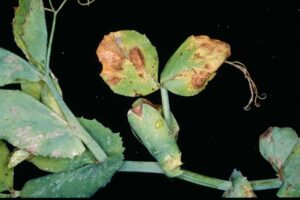
Favorable Conditions-
High humidity and cool temperature of about 5-15oC favors the growth of this disease.
Management-
- Application of Chlorothalonil @2ml/L of water.
- Application of Copper sulfate @1mg/L of water.
- Rotate crops with non-host crops.
- Remove dead and infested crops from the field and maintain field sanitation.
- Avoid excessive fertilization.
- Use disease resistant varieties.
- Powdery Mildew-
Causal Organism- Erysiphe pisi
Symptoms-
- White, powdery spots on the top or bottom of leaves, along with curled leaf edges and purple or red splotches.
- In severe cases, tissues become distorted or stunted.
- The fungus can spread to the fruit, creating a white, powdery mycelial growth on the seeds, giving the fruit a dusty look.
- Fruit surface may also be hardened and crack.
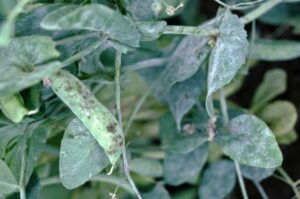
Favorable Conditions-
Optimum temperature of about 20-25oC, high humidity above 75% favors the growth of this disease.
Management-
- Use disease resistant varieties.
- Practice crop rotation to avoid risk of spread of disease.
- Remove and destroy the affected plant from the field and maintain field sanitation.
- Apply any one of the following fungicides-
Difenoconazole 25%EC @2ml/L of water
Copper oxychloride 50 WP @2gm/L of water
- Rust-
Causal Organism- Uromyces fabae
Symptoms-
- Pea rust is a fungal infection that starts as tiny, light-colored spots on pea plant leaves. These spots eventually grow into pustules that release spores.
- Pustules from pea rust may be orange, yellow, brown, black, or white, but the rusty brown color common among them is the reason for the disease’s name.
- The pustules generally appear on the underside of leaves, but they can also be seen on leaf stalks, stems, flowers, and fruit.
- In cases of severe infection, leaves may turn yellow and drop off earlier than usual.
- Severe infections can shrink seed size and lead to yield reductions of up to 30%.
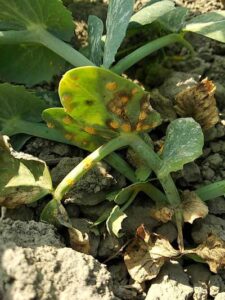
Favorable Conditions-
High Relative Humidity above 90%, Warm with humid weather favors the growth of this disease.
Management-
- Use healthy and certified seeds
- Application of Propiconazole 25%EC @1ml/L of water.
- Bacterial Blight-
Causal Organism- Pseudomonas syringae
Symptoms-
- Tiny, dark green spots that are water-soaked often develop on the leaves and stipules, typically starting near the base of the leaf.
- The spots may initially appear yellowish before turning brown and becoming papery.
- Pods may initially show water-soaked areas that later become sunken and turn olive-brown.
- Pods infected early in their development may become twisted or bent.
- As the infection progresses, the spots on the pods can develop into reddish-brown and become sunken.
- Stem lesions often begin near the ground level as water-soaked patches.
- As these spots progress, they may turn olive-green to dark brown, blend together, and cause the stem to wither and die.
- Flowers exhibiting a scorched appearance and showing signs of decline.
- Discolored and shriveled seeds that are notably small.

Favorable Conditions-
Wet Weather, Light rain, high humidity favors the growth of this disease.
Management-
- Plant disease free seedlings.
- Practice crop rotation to minimize the risk of spread of disease.
- Avoid early sowing
- Remove and destroy the infected plants from the field and maintain field sanitation.
- Fungicide such as Tebuconazole 6.7% + Captan26.9% @2.5ml/L of water can be used to treat this disease.
- Gray Mold-
Causal Organism- Botrytis cinerea
Symptoms-
- Light brown patches on the leaves or grey-brown lesions may be observed.
- Irregular, water-soaked lesions or pod rot often develop at the base of the style.
- Tiny round spots, known as “pocks,” may enlarge into larger lesions, while flowers can decay into a rotting mass.
- Reduced pod formation, leaf and flower drop, breaking of tender branches, and premature wilting and ripening of affected plants.
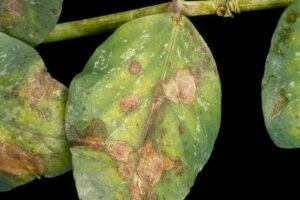
Favorable Conditions-
Moist and warm temperature of about 18-23oC, high humidity favors the growth of this disease.
Management-
- Use disease resistant varieties.
- Avoid planting near stubble.
- Remove and destroy the infected plants from the field and maintain field sanitation.
- Apply Captan 50 WP @1-2gm/L of water
- White Rot-
Causal Organism- Sclerotinia sclerotiorum
Symptoms-
- Leaves show yellowing from the tips inward.
- Wilting and die back of leaves
- At the plant base, there is a cottony white mold with tiny black dots embedded in it.
Favorable Conditions-
High Humidity, warm temperature of about 15-25oC, light rain splashes favors the growth of this disease.
Management-
- Rotate crops with non-host plants, as this can help prevent the buildup of inoculum in the soil.
- Plant disease resistant variety.
- Application of Tebuconazole 250 EC @1ml/L of water.
- Root Rot-
Causal Organism- Fusarium solani
Symptoms-
- Root systems may be underdeveloped, showing fewer lateral roots and nodules. Roots can be discolored, varying from brown to black, with lesions that may appear red, black, or grayish. In severe cases, roots might turn black and decay.
- Affected plants might display reduced growth, with leaves turning yellow and eventually leading to dieback.
- Leaves may droop and wilt, while the basal leaves could be stunted and show yellowing or necrotic symptoms.
- Symptoms may also include a decrease in overall yield, soft lesions that appear watery, and red discoloration of the vascular system.
Favorable Conditions-
Low soil moisture, soil temperature between 22-27oC, acidic soils, warmer conditions favors the growth of this disease.
Management-
- Practice crop rotation
- Use high quality, disease free seeds.
- Apply Carbendazim 50%WP @2gm/L of water.
- Wilt-
Causal Organism- Fusarium oxysporum
Symptoms-
- Stunted Growth of the plants
- Yellowing and wilting of leaves.
- Reddish brown discoloration of the xylem vessels
- White, Pink or orange fungal growth on the outside of affected stems.
- Decay of stems and roots
- Leaflet margin curl downward and inward
- Stem may be slightly swollen and brittle near the soil.
- In severe cases plants may die
Favorable Conditions-
A soil temperature of 23-27oC, Prolonged high humidity, poor soil drainage favors the growth of this disease.
Management-
- Cultivate resistant variety.
- Rotate crops with non-leguminous crop
- Remove and destroy the infected plants from the field and maintain field sanitation.
- Don’t plant peas after certain crops such as potatoes and beans.
- Avoid replanting peas in the same soil.
- Avoid weeding after flower buds.
- Apply Carbendazim 50%WP @2gm/L of water
Harvesting-
Harvest the peas when they are fully developed but still tender. The pods should be plump and firm. If you wait too long, the peas inside might become starchy and less sweet. Use your fingers or scissors to snip the pods from the plant. Be gentle to avoid damaging the plant or other pods.
Yield-
Yield depends on different factors such as Variety used, climatic conditions, agronomic practices. The average yield of Peas are about 50-60qntl/acre.
copyright © 2020 ISP. all right reserved.
